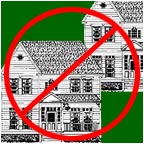


Protect the Partrick Wetlands
and our Community
![]()
|
Says Common Council President Commentary in the Norwalk Hour
|

|
Norwalk's land use and political agencies, as well as Mayor Alex Knopp, subscribe to "smart growth" principles. Nonetheless, the city is officially on record as supporting the extension of the Newtown Avenue sewer simply because a Westport developer promised to pay for it -- if Westport approves his plan to build 22 homes in the wooded Partrick Wetlands. That the sewer extension could eventually lead to the over-development of a wooded residential area in the Cranbury section of Norwalk seems to have been lost in the discussion, trumped by the prospect of getting something for free.
I believe it's time for Norwalk's law department and the special Cranbury Task Force to examine the possibility of rescinding approval of the sewer extension.
Another example of a something happening, or even getting worse, despite extensive and highly vocal opposition, is traffic congestion. Northeast Norwalk, much of which is called Cranbury, and the northwestern portion of Westport, are cases in point.
Partrick Road, which connects Newtown Avenue and Wilton Road in Westport, already is dangerous because it was not built to handle the amount of traffic that uses it, much of it for shortcuts because the main roads are too congested. Nonetheless, there are currently three projects in the works (a fourth was already approved, and construction has started) that could drastically increase the amount of traffic on Partrick.
Proposed are a 13-home development on the White Barn Theatre property in Norwalk, the above-mentioned 22 cluster homes in the Partrick Wetlands, and possibly 400 units on the Pepperidge Farms property, which is some distance away. The last proposal will increase traffic on Westport Avenue on weekends, thus forcing more folks to use Partrick as a shortcut between northern Norwalk and Westport.
Almost everyone agrees traffic is a huge problem in Fairfield County. So why do these proposals stand a good chance of being approved? One reason is the antiquated nature of our zoning and subdivision regulations. Another is the simple fact that more than one town is involved, which means the overall impact of the proposals, together, is never considered; and another reason is the land is privately held, making it difficult for municipalities to effectively intervene.
Norwalk needs to take a careful look at its zoning and subdivision regulations. We need to know if they conform to the state's best practice standards; if they differ from those of surrounding towns that have had success curbing development in peripheral areas. And are they consistent with the vision of Norwalk embodied in the Master Plan of Development, which is currently being updated?
Fortunately, energetic neighborhood associations in Norwalk and Westport are trying to preserve the character and quality of life, not to mention the property values, of their communities. Mayor Knopp and local political officials are working closely with the Cranbury Neighborhood Association to prevent the over-development of the 18-acre White Barn Theatre property.
But the question remains: Why do so many folks need to work so hard to prevent what virtually everyone agrees needs to be prevented?
Bruce Kimmel
Mr. Kimmel is president of Norwalk's elected common council